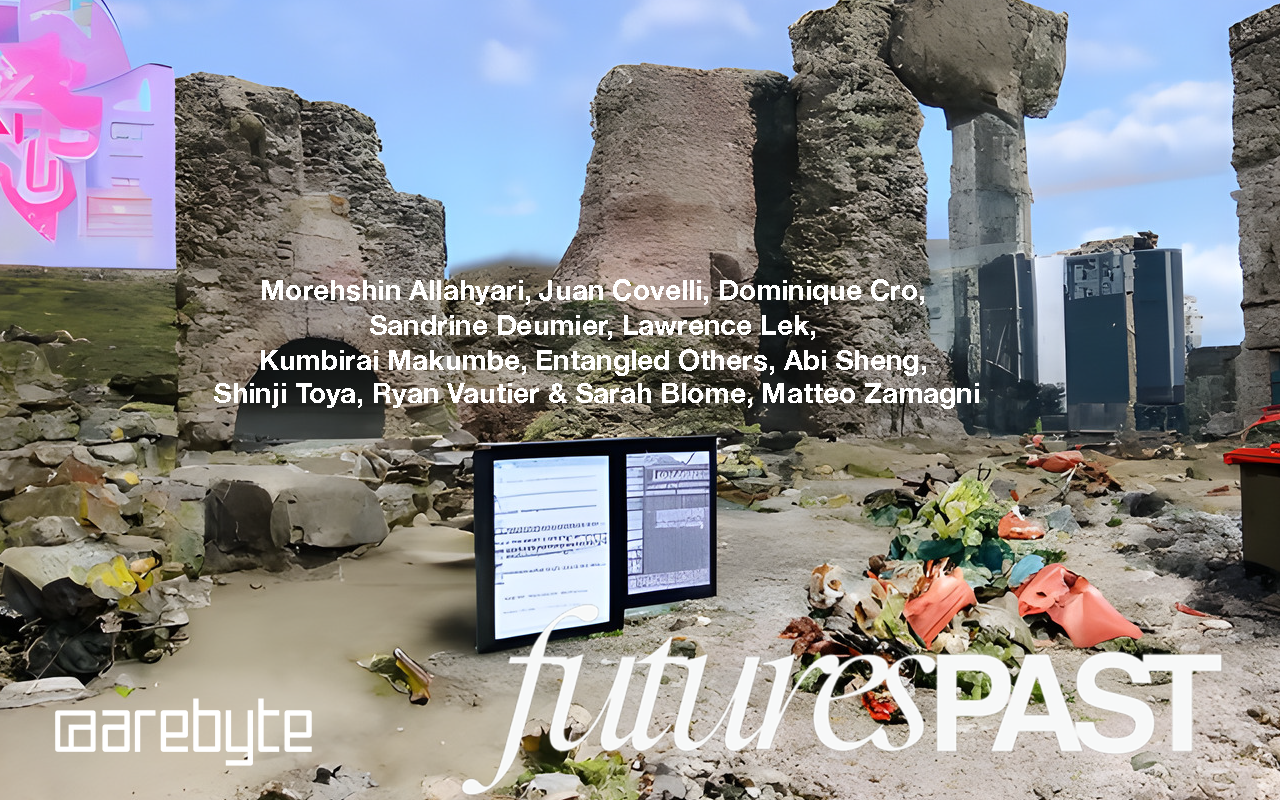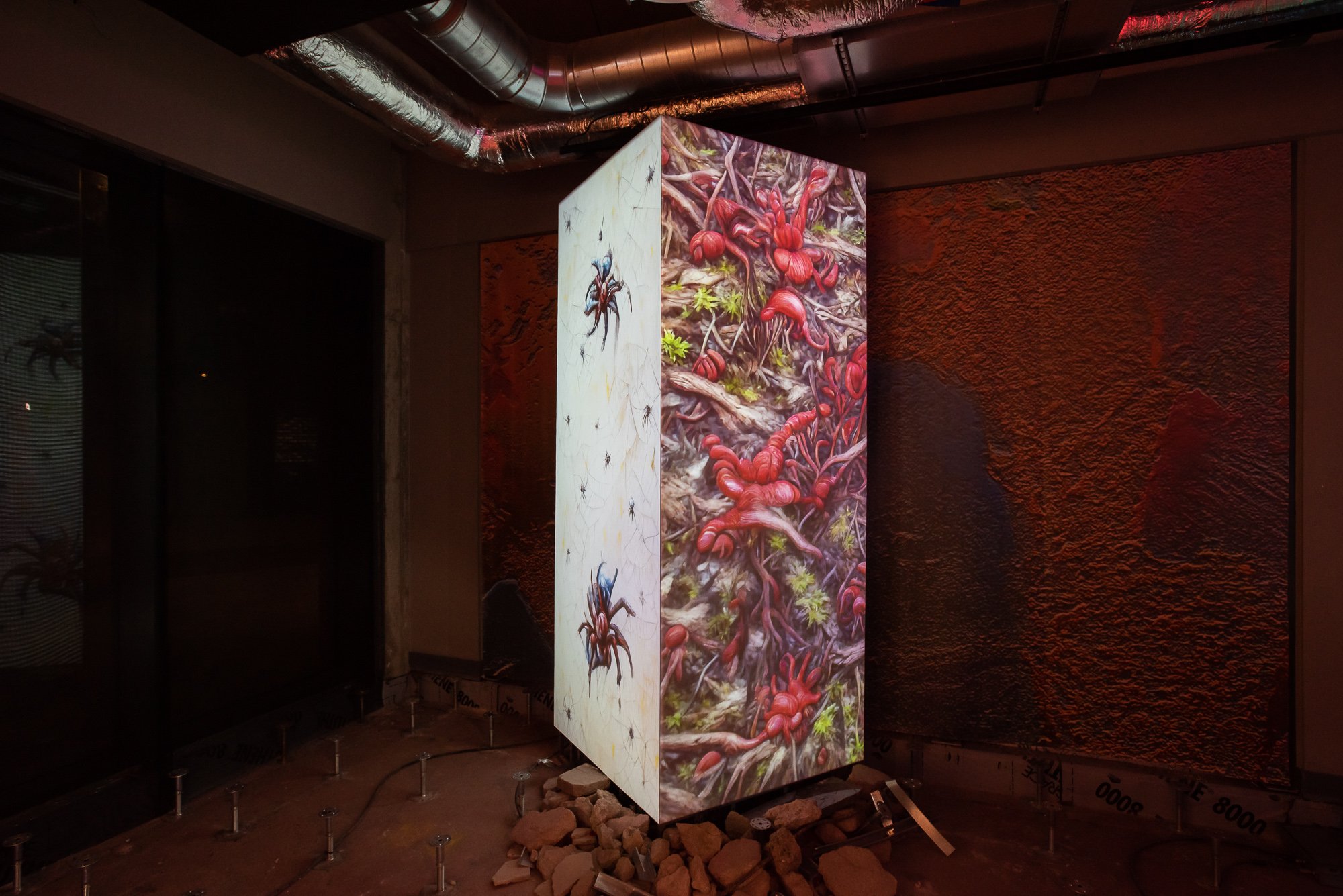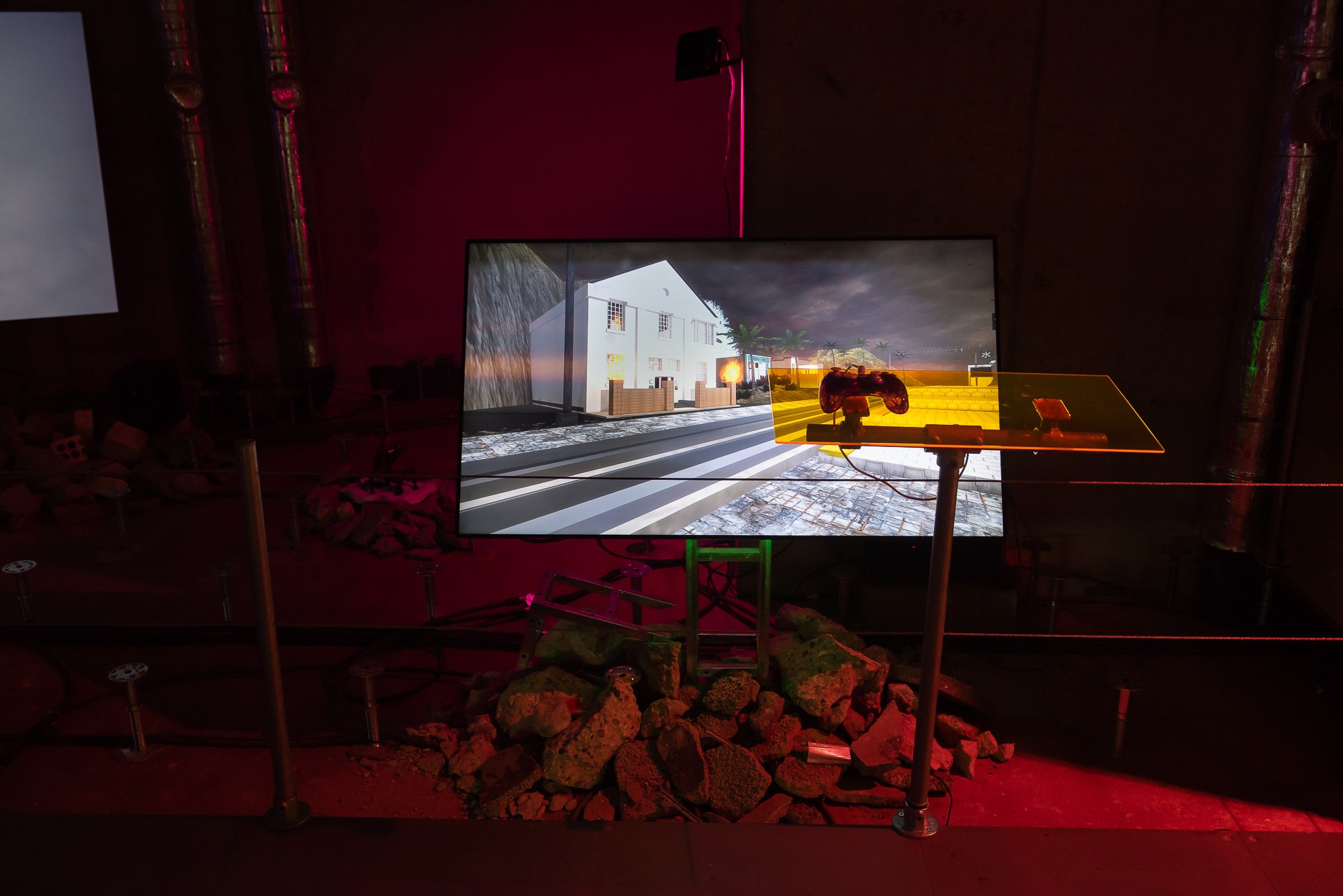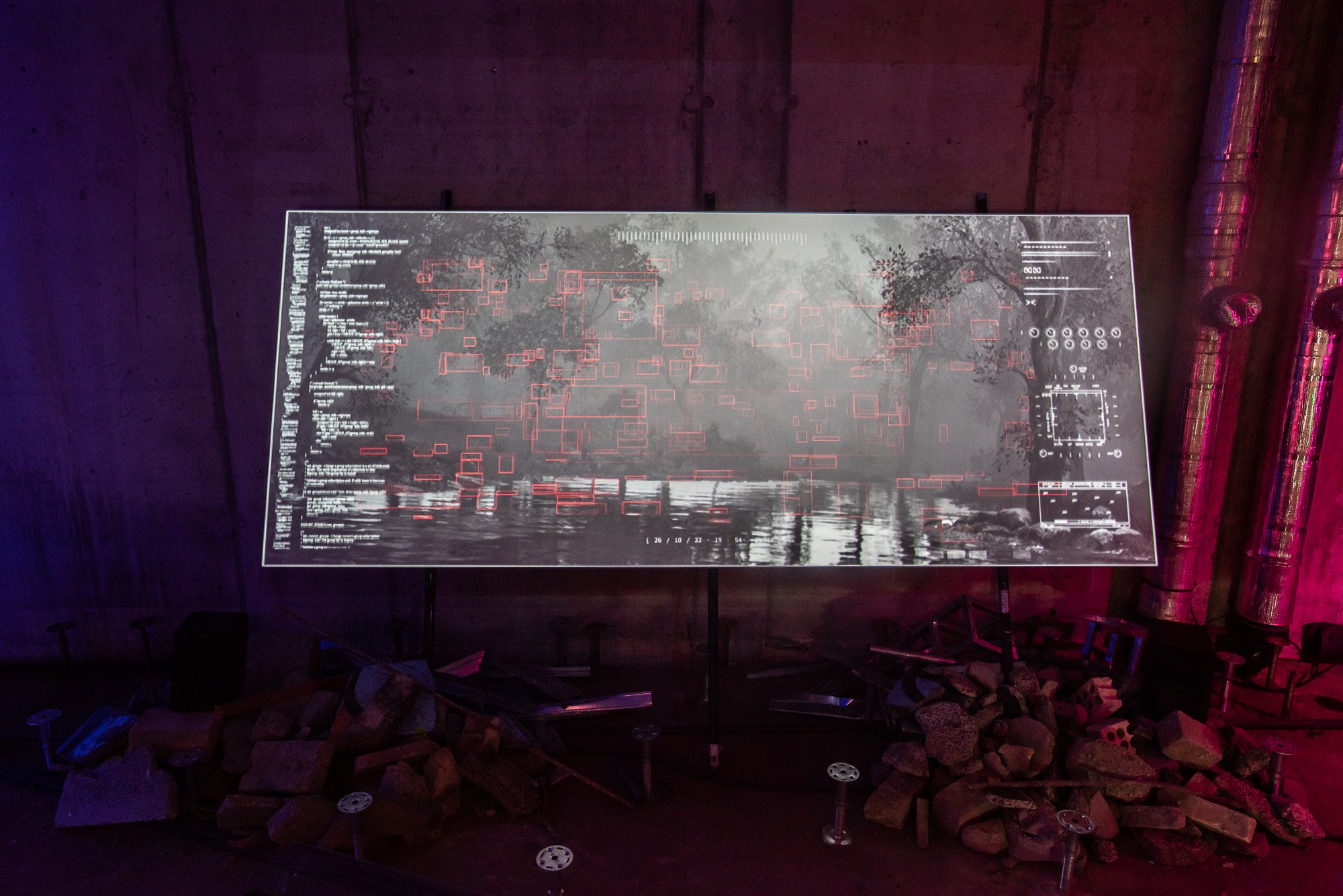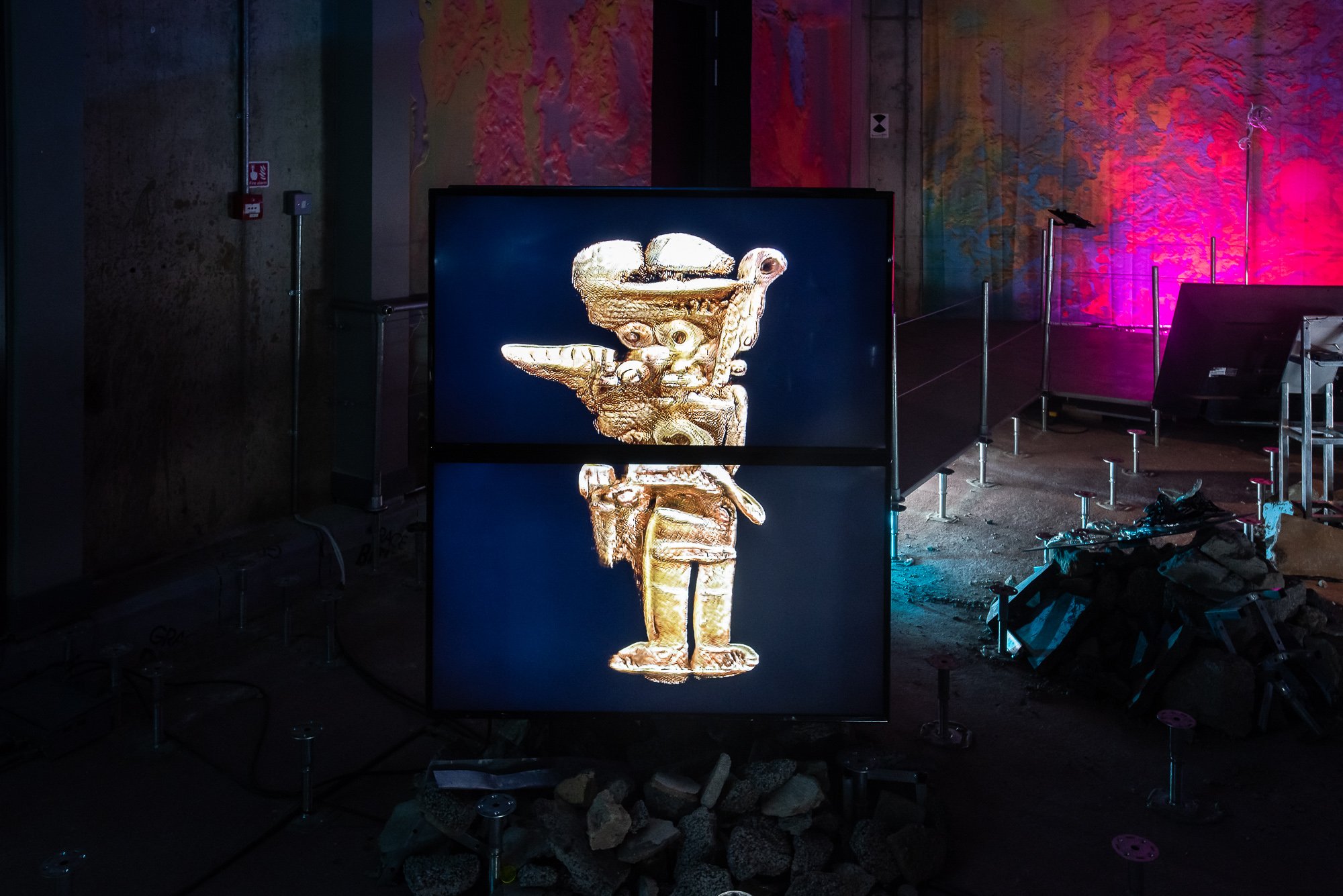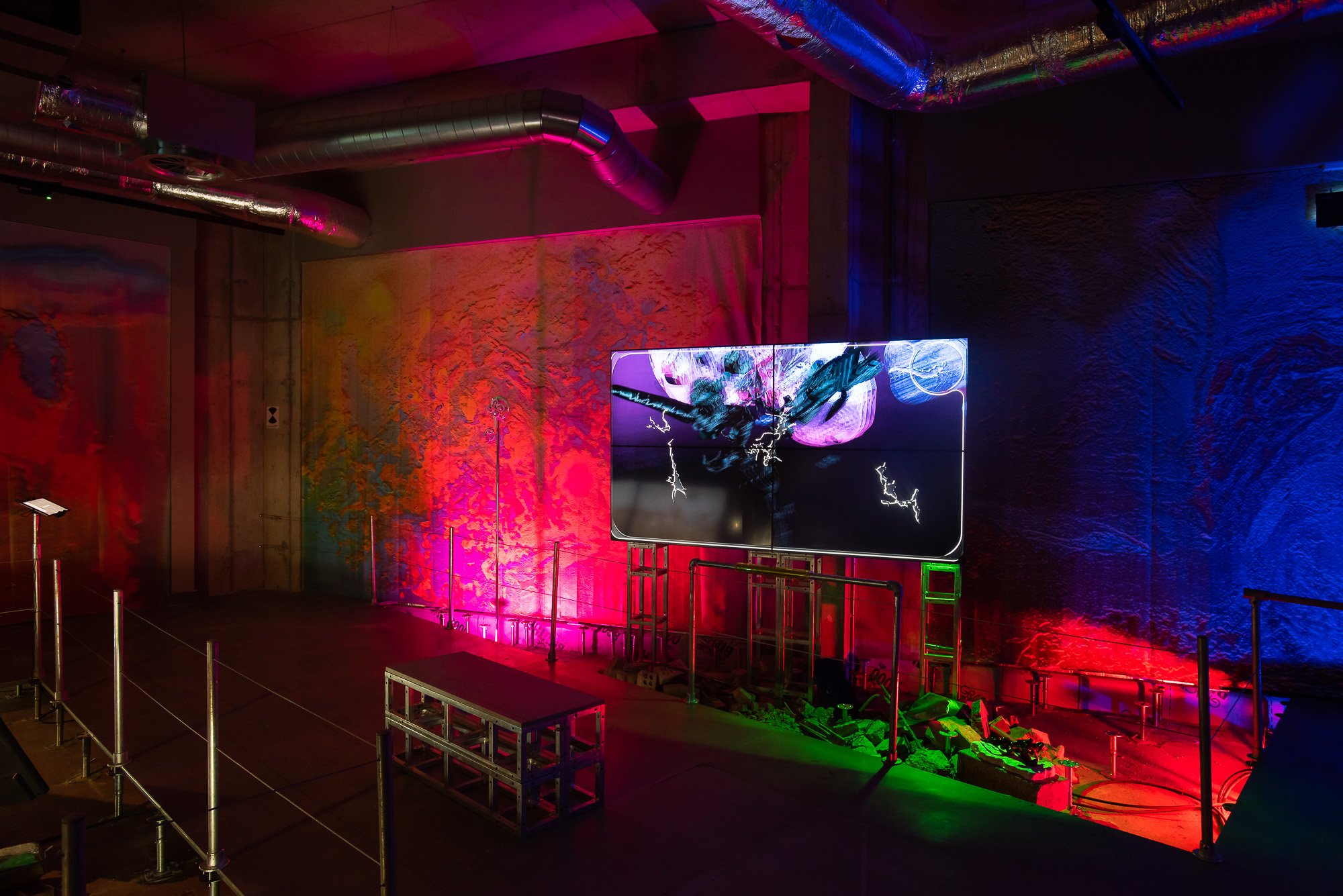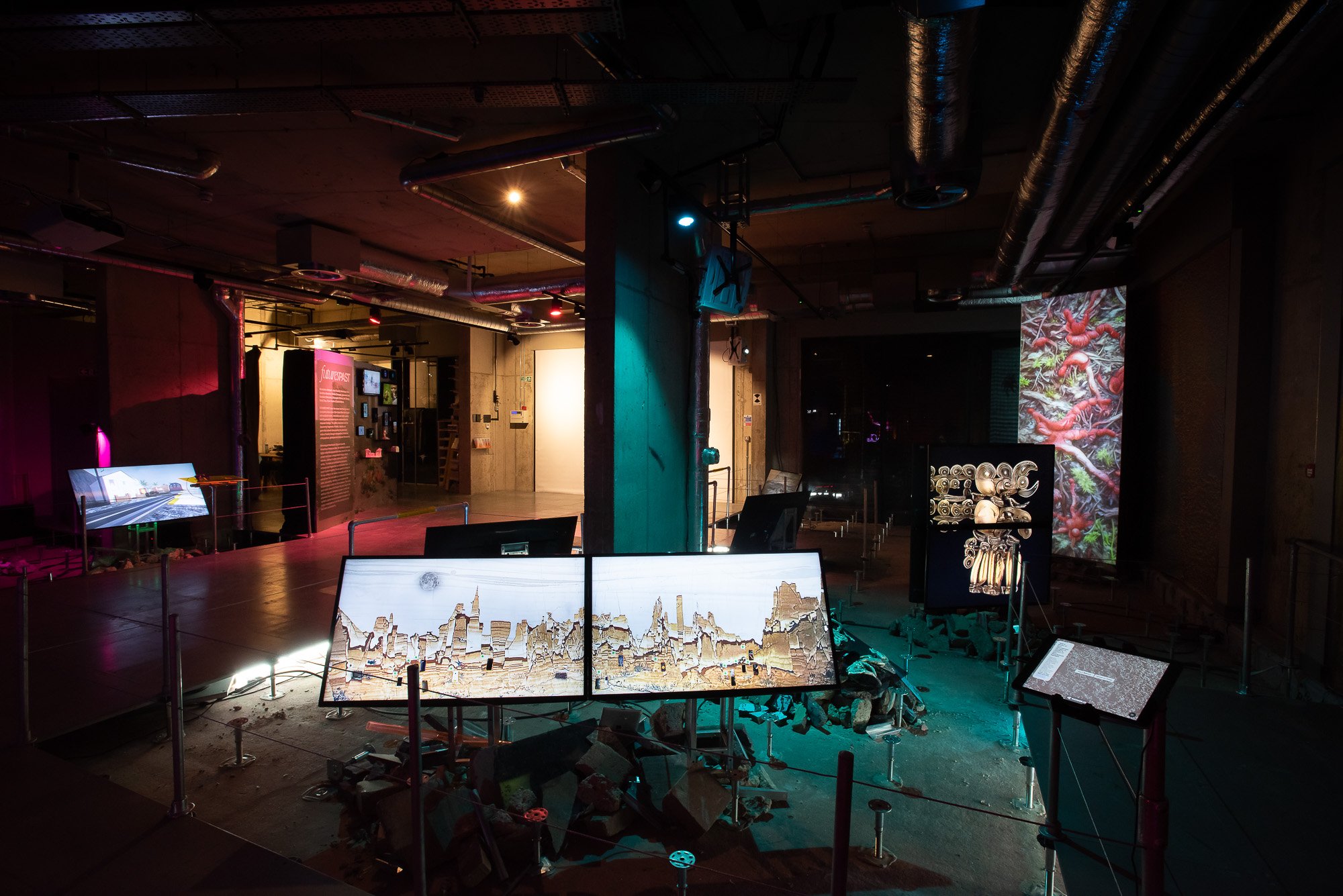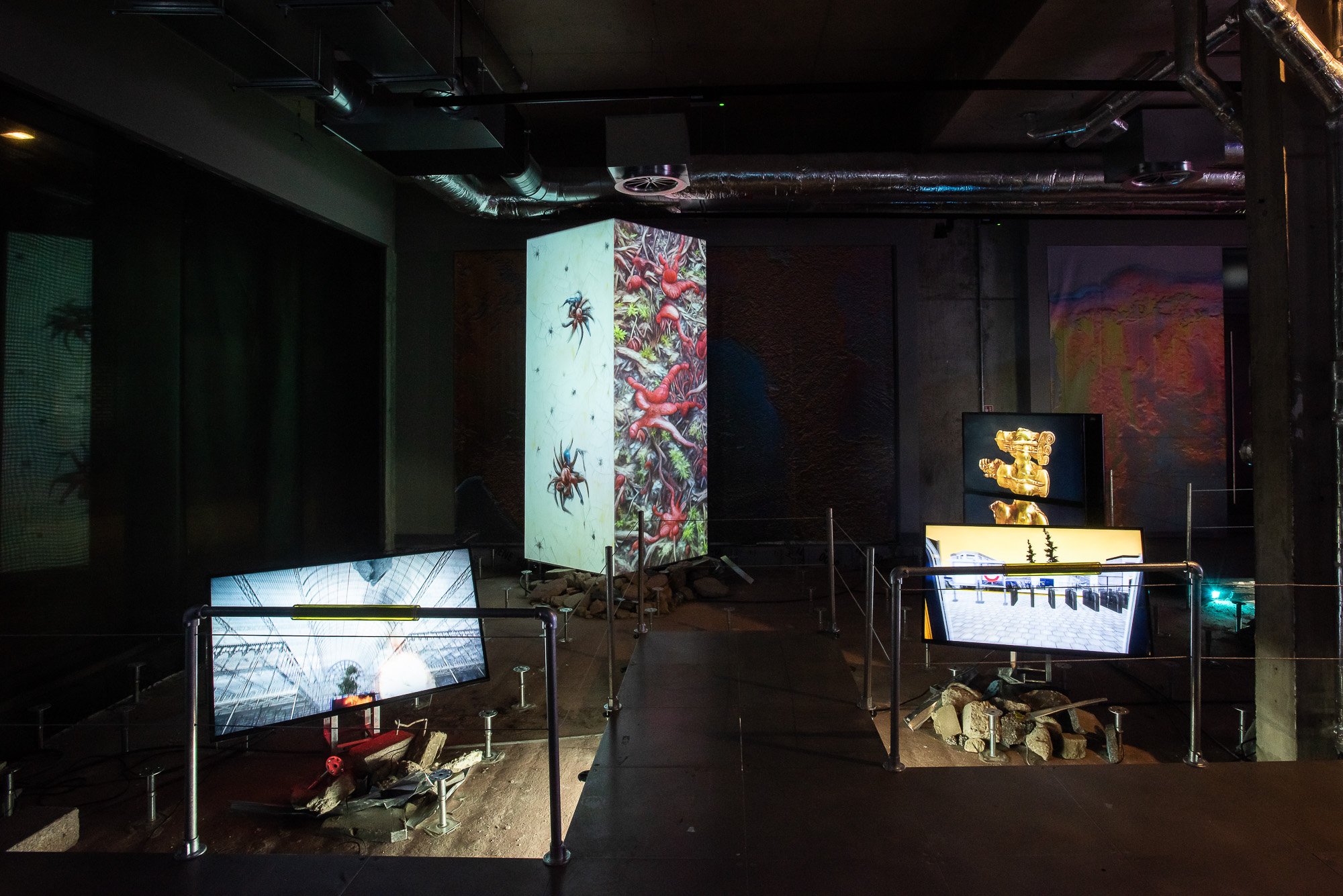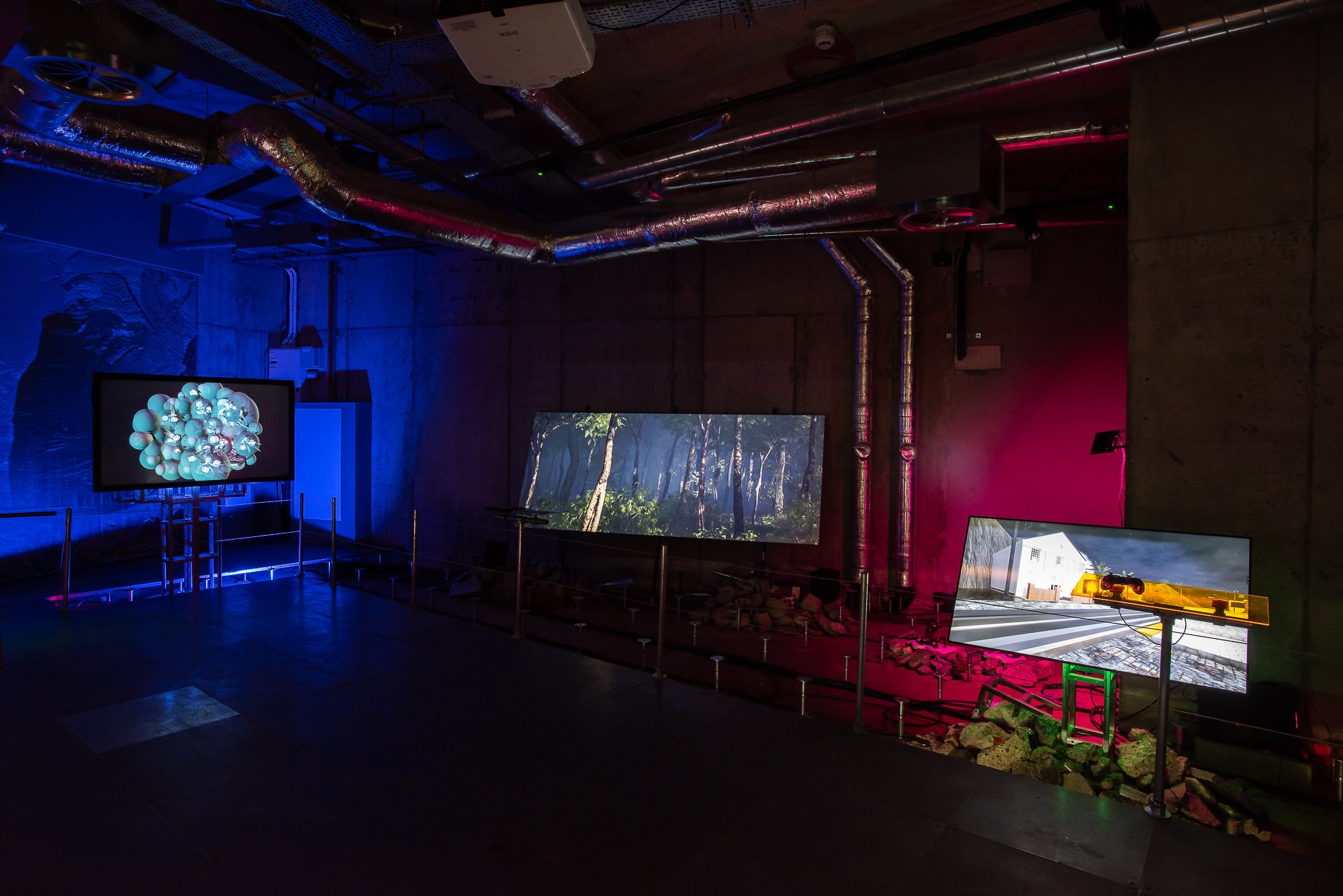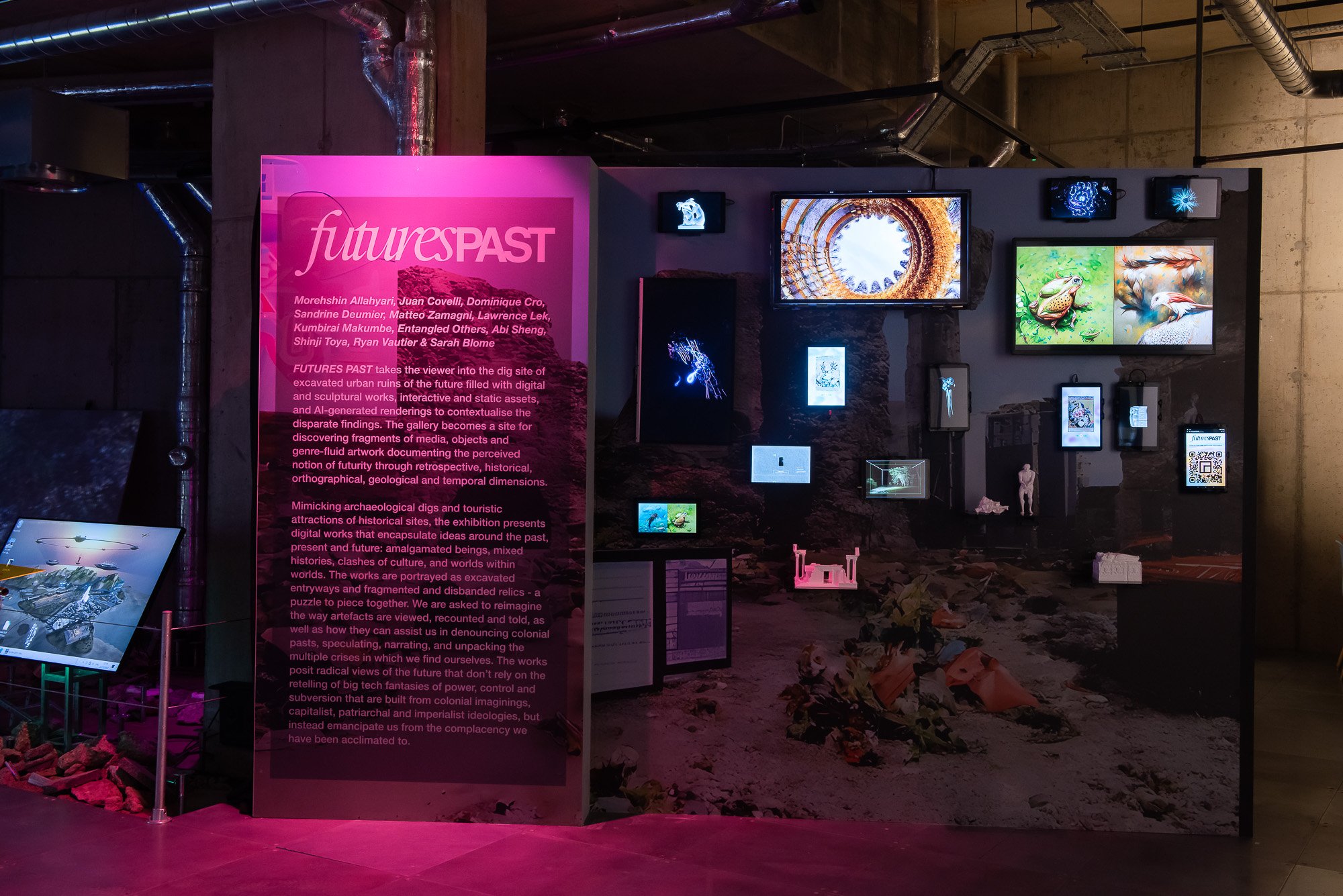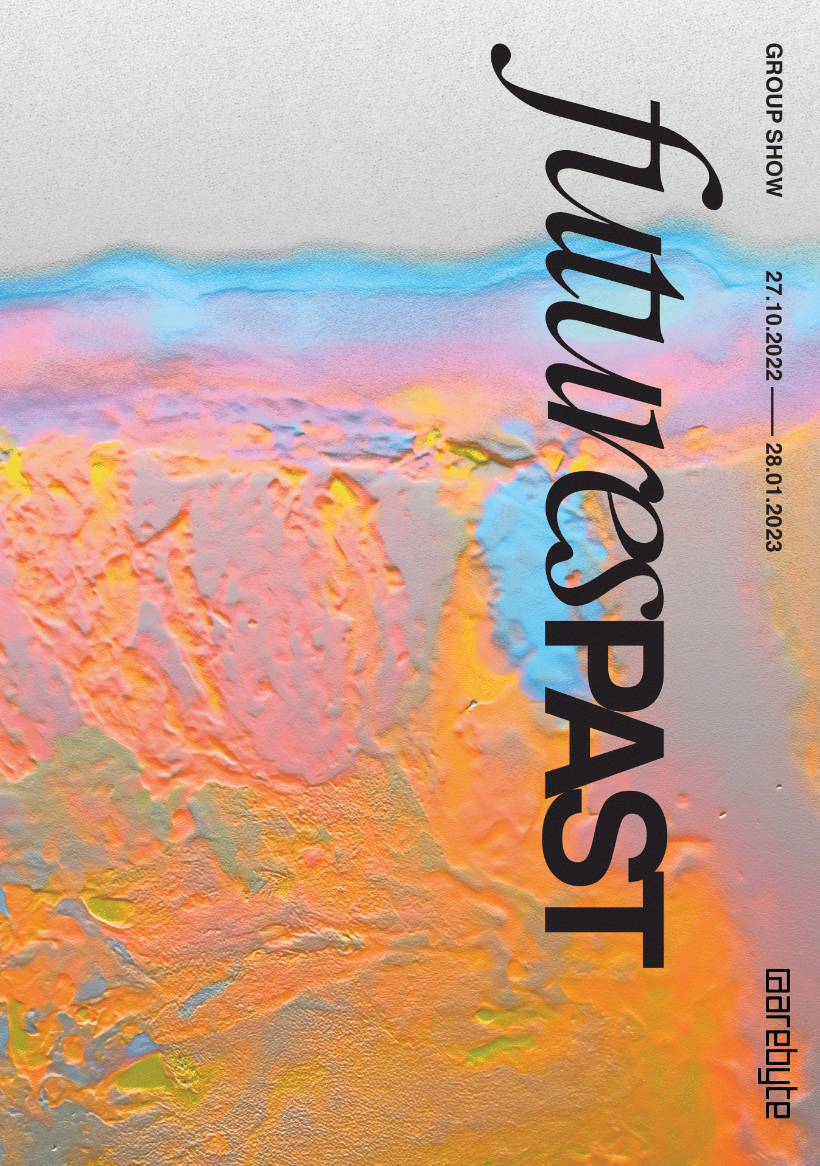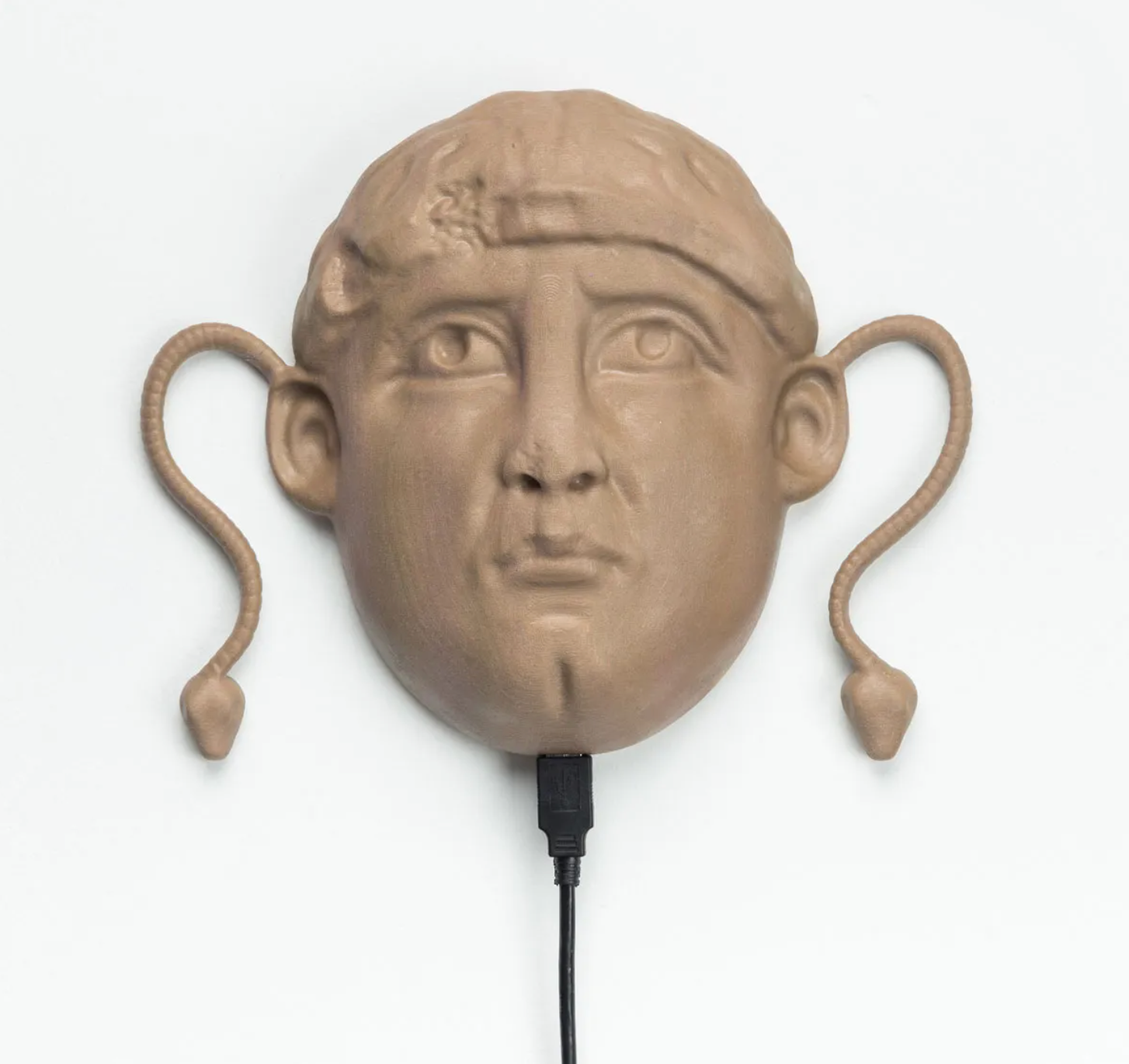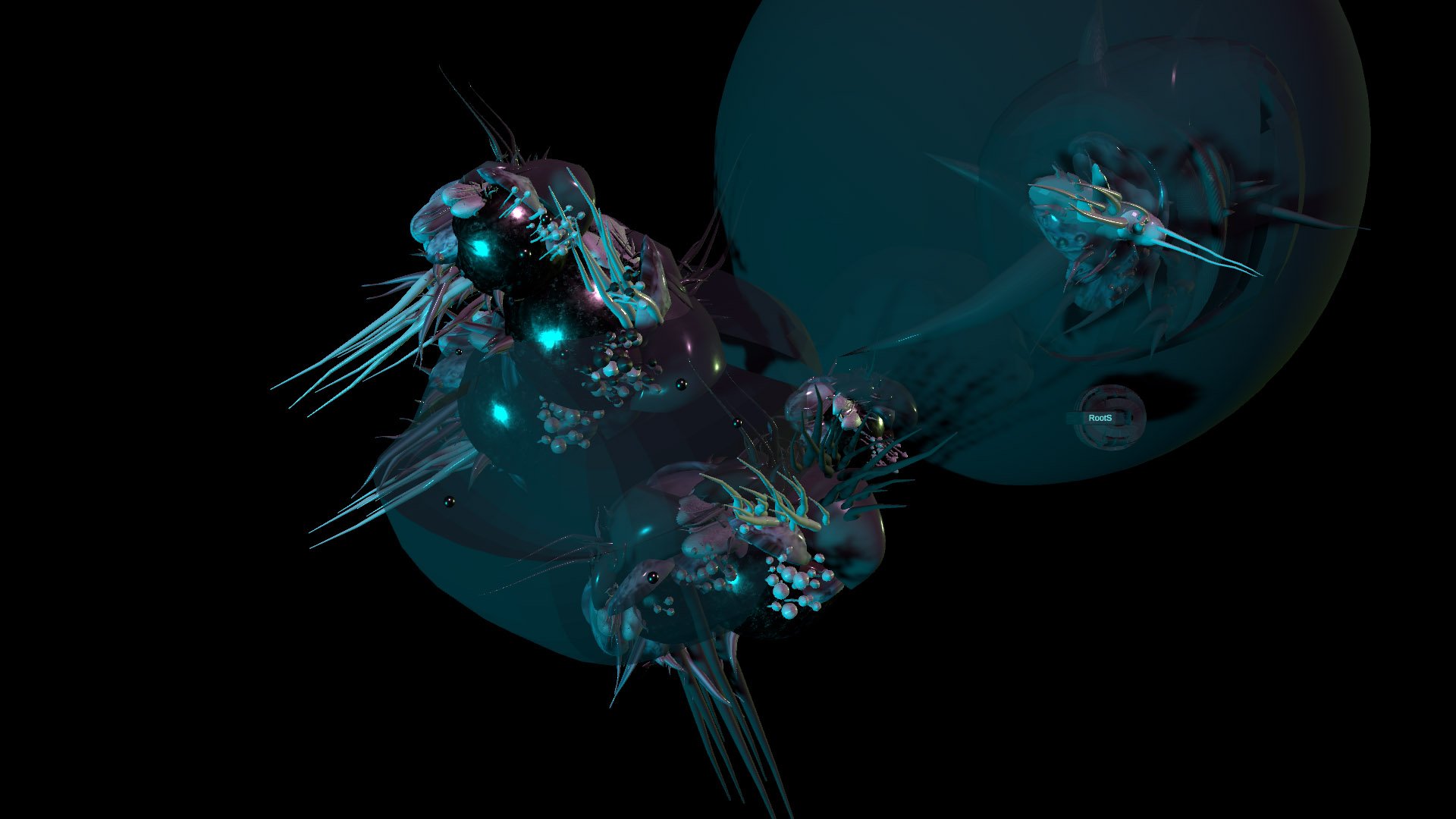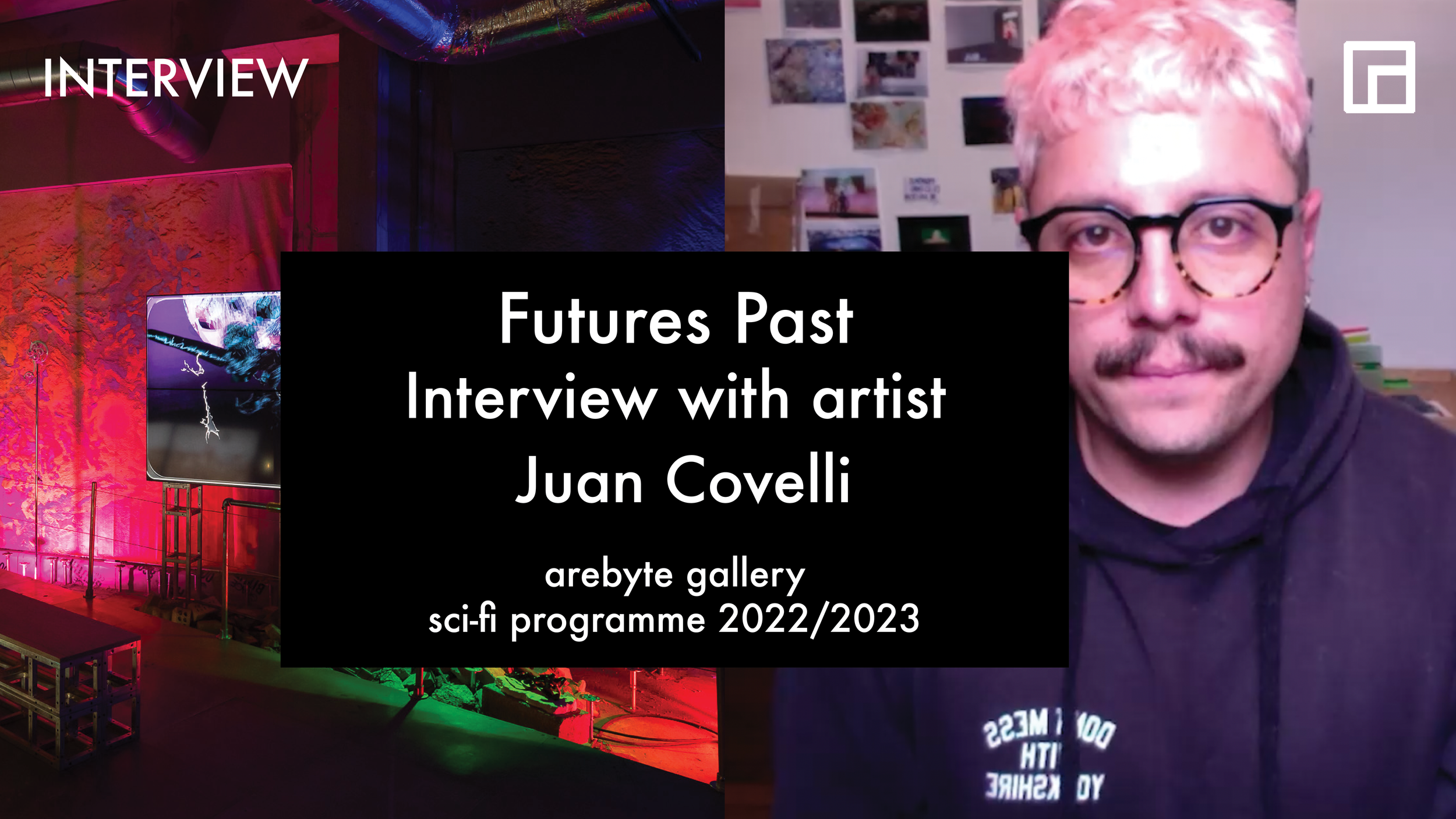FUTURES PAST
Morehshin Allahyari, Juan Covelli, Dominique Cro, Sandrine Deumier, Matteo Zamagni, Lawrence Lek, Kumbirai Makumbe, Entangled Others, Abi Sheng, Shinji Toya, Ryan Vautier & Sarah Blome
Part of arebyte 2022/23 programme Sci-Fi
Opening Event : Thu 27 Oct 2022 6:30pm
Exhibition runs until 28 Jan 2023
Tue - Sat 1-6 pm
An immersive journey through the excavated ruins of the future
arebyte presents Futures Past, a group show as part of arebyte's 2022/23 programme Sci-Fi which looks at fictioning and alternative futures through a series of exhibitions, live performances, online experiences and educational activities.
Futures Past takes the viewer on an immersive journey through the excavated ruins of the future filled with digital and sculptural works, interactive and static assets, as well as AI-generated renderings to contextualise the disparate findings. The gallery becomes a site for discovering fragments of media, objects and genre-fluid artwork documenting the perceived notion of futurity through retrospective, historical, orthographical, geological and temporal dimensions.
Mimicking archaeological digs and touristic attractions of historical sites, the exhibition presents digital works that encapsulate ideas around the past, present and future: amalgamated beings, mixed histories, clashes of culture, and worlds within worlds. The works are portrayed as excavated entryways and fragmented and disbanded relics - a puzzle to piece together. We are asked to reimagine the way artefacts are viewed, recounted and told, as well as how they can assist us in denouncing colonial pasts, speculating, narrating, and unpacking the multiple crises in which we find ourselves. The works posit radical views of the future that don’t rely on the retelling of big tech fantasies of power, control and subversion that are built from colonial imaginings, capitalist, patriarchal and imperialist ideologies, but instead emancipate us from the complacency we have been acclimated to. What might become of the future we will never inhabit is not clear - we know where the future is but not entirely what it is. The exhibition covers four modes of seeing - this is not to presume what the future will look like but rather to think about how the future is seen through the lenses of past, present, future and preservation. Adopting the notions Benjamin Noys puts forward, this could be rephrased as “de-inventing” the future and returning to the present as a “fraught and fragmentary site of struggle.”
The gallery takes on a new purpose as a site for archiving and preservation; a mediator for concepts of futurity whose glitched screens and leaky disc spaces are identifiable as belonging to our present, the early twenty-first century, but whose artefacts belong to another time. Now in recovery and recontextualised as excavated portals (a temporal non-place) the works seek renewed attention and frameworks, they become ominous adages as well as bright suspicions of tomorrow. The works have been found to remind us of possible, probable and preferable futures (to adopt the language from Futures Thinking theory) and ask how technology can assist in developing more of an understanding of the hereafter.
Contained within them are ghostly remnants of the nascent and full-fledged critical exchanges surrounding the multiscalar crises of the present, not wanting to be forgotten, forever embedded within our collective memory. In their age of total recall, memory is never lost.
Acting in flux within the exhibition are temporal, cosmological, mystical and fictitious renderings articulated within the terms excavation, future and history. The Western notion of time is linear; time flows as a straight line. On a continuum, the past is to the left, and the future is to the right; events are thus chronologically recorded, one following the other.
To know your future you must know your past is a sentiment shared by many great thinkers and writers of the last century, but Futures Past asks us to reconsider this by looking at our present from the eyes of the future - instead, to walk backwards into the future with eyes fixed on the past. Seeing time and all it encompasses as circular, or nonlinear, allows for more spiritual and progressive articulations on how we might live in the future, present and past synchronically.
In Patricia Waugh and Marc Botha’s book, Future Theory, the interrogation of terms and concepts deemed central to change are categorised into five key concepts – boundaries, organisation, rupture, novelty, and futurity. To use these categories to expand on the works in Futures Past we can build an understanding of how artists are using theories and concepts applied to a constantly shifting world.
Exploring rupture and futurity in the exhibition and addressing climate change, extractivism and the Anthropocene are works by Matteo Zamagni, Entangled Others, Shinji Toya and Dominique Cro. These works provide insights into organic evolutionary processes and electronic evolutionary processes via machine sentience and remixing data.
Thinking through boundaries and organisation, and addressing colonial practices and ownership of relics and artefacts in the exhibition are works by Morehshin Allahyari and Juan Covelli. In these works, one of which has relied on 3D printing as a medium and as a “technology for remodelling thought into new shapes”, a critique on representation as a technology of colonial domination over nature and territory is exemplified. In the (sometimes) open-source method of creation and dissemination of the works, as well as the cultures that the work speaks for, the inclusion of such works aims to expose in-betweens, to engage with empowering the powerless, and questioning the presupposed. Further exploration into the dissemination of data and cultural property is the incorporation of 3D printed objects from the open-source collection Three D Scans, a project initiated in 2012 by Oliver Laric that aims to make museums’ permanent collections available to an audience outside of its geographic proximity.
Conveying novelty and futurity, and addressing post-human and cyborgian threads are works by Kumbirai Makumbe and Abi Sheng as well as the videos by Ryan Vautier and Sarah Blome. These works interrogate the body as a site for emotional emancipation together with the notion of reaching a technological singularity.
Figuring novelty and boundaries, and addressing worldbuilding within the realm of future thinking are works by Lawrence Lek and Sandrine Duemier. The works add gamification to the idea of altered states of presence and memory that exist in digital space questioning our capacity to perceive the living world as a complex entity.
In addition to the floor-based works, fragments of selected artists' works are presented on a display wall akin to museological displays. Unlike traditional display cases, the assets (which include untethered CGI models, 3D printed objects, and gifs) are preserved within the digital and mostly bound to the medium of the screen. By separating out various elements from the artist's work, the wall questions collection, archiving and conservation of digital practices and highlights the importance of treating it in the same way as more traditional and ephemeral practice; holistically and with attention to lineage and provenance.
-
Media archaeology starts with the archive. Reclaiming an imagining of the future operates within the boundaries of the past; inherently political and forever imbued with colonialist regimes and imperialist orders set out to marginalise and weaponise power, a renewed thinking toward a future we could envisage as livable requires reprogramming of many variables. In the context of an archaeological excavation site, the works become saturated with an inclination for documentation, counting, numbering, situating (temporally) and archiving. The way we understand and treat archival material, and the way material becomes archived changes depending upon the object in question. Unlike digital media archives, analogue media archives should be preserved and not played as “each replay is a partial erasure… Digital preservation relies instead on the frequent rereading, erasure and rewriting of the content”. Unlike earlier models of archiving which seem to freeze time, archiving in the digital sense could be described as an archive in motion. Unearthing these digital findings, reanimating them and replaying them rekindles them and keeps them alive and whole - in direct opposition to that of standardised museum archives and displays which fetishise fragments, fragility and decay. Here, cultural material and ephemera pile up and become fodder for the Earth as decades go by - what do we choose to keep and what becomes discarded to compression within strata?
EVENTS PROGRAMME
Opening Party
Thu 27 Oct 2022, 6:30-9pm
arebyte Gallery, unticketed event
Join us for the opening night of Futures Past
Curated Tour
Sat 19th Nov, 2pm - 2:45pm
arebyte Gallery, Free unticketed event
Join arebyte Gallery curator Rebecca Edwards in an informal curatorial tour of the FUTURES PAST exhibition. Hear about the artists’ work in relation to the themes within the exhibition and the wider arebyte programme.
Curated Tour
Sat 3rd Dec, 2pm - 2:45pm
arebyte Gallery, Free unticketed event
Join arebyte Gallery curator Rebecca Edwards in an informal curatorial tour of the FUTURES PAST exhibition. Hear about the artists’ work in relation to the themes within the exhibition and the wider arebyte programme.
Curated Tour
Sat 14th Jan, 2pm - 2:45pm
arebyte Gallery, Free unticketed event
Join arebyte Gallery curator Rebecca Edwards in an informal curatorial tour of the FUTURES PAST exhibition. Hear about the artists’ work in relation to the themes within the exhibition and the wider arebyte programme.
arebyte x A Sci Fi Curriculum
Sat 14th Jan, 4pm - 6pm
arebyte Gallery, Free tickets here
Join arebyte curator Rebecca Edwards and multimedia artist and Collective Ending member Yuli Serfaty in a reading group session centred around the themes within the exhibition FUTURES PAST. Reading extracts from Ursula K. Le Guin and others, the group will discuss how these texts can contextualise our present with a lens on the past and future.
More info of the event and the reading list here
EXHIBITION CREDITS
Participating artists: Morehshin Allahyari, Juan Covelli, Dominique Cro, Sandrine Deumier, Matteo Zamagni, Lawrence Lek, Kumbirai Makumbe, Entangled Others, Abi Sheng, Shinji Toya, Ryan Vautier & Sarah Blome, 3D Scans (a project initiated by Oliver Laric).
Curation & Set Design: Rebecca Edwards, Nimrod Vardi
Production: Rebecca Edwards, Nimrod Vardi, with assistance from Kaan Amjad
Technical Installation & Fabrication: Edd Butterworth, George Browne, Isaac Grubb; with assistance from Debbie Spink (Vinyl) and Rob Hall (3D Printing)
Communications: Claudel Goy, Giulia Ponzano (Press), Clauresse Amo-Yartey (Marketing)
Video Production: Marc Blazel (Production), Shane Sutherland (Editing)
Photography: Max Colson
Exhibition Branding: Studio Basic, Sachi Patil
READ THE EXHIBITION BOOKLET
Guest contributors: Rebecca Edwards, Corinna Gardner, Morehshin Allahyari, Dr Jussi Parikka, Dr Daniel Rourke
ARTIST BIOS
Morehshin Allayhari, Material Speculation: ISIS: South Ivan Human Heads: Medusa Head, 2017
Morehshin Allahyari (Persian: موره شین اللهیاری), is a NY based Iranian-Kurdish artist using 3D simulation, video, sculpture, and digital fabrication as tools to re-figure myth and history. Through archival practices and storytelling, her work weaves together complex counternarratives in opposition to the lasting influence of Western technological colonialism in the context of SWANA (Southwest Asia and North Africa). Morehshin has been part of numerous exhibitions, festivals, and workshops around the world including Venice Biennale di Archittectura, New Museum, The Whitney Museum of American Art, Pompidou Center, Museum of Contemporary Art in Montreal, Tate Modern, Queens Museum, Pori Museum, Powerhouse Museum, Dallas Museum of Art, and Museum für Angewandte Kunst. She has been an artist in residence at BANFF Centre, Carnegie Mellon University’s STUDIO for Creative Inquiry, Autodesk Pier9 Workshop in San Francisco, the Vilém Flusser Residency Program for Artistic Research in association with Transmediale, Berlin, Eyebeam’s one year Research Residency, Pioneer Works, and Harvest Works. Her work has been featured in The New York Times, BBC, Huffington Post, Wired, National Public Radio, Parkett Art Magazine, Frieze, Rhizome, Hyperallergic, and Al Jazeera, among others.
Juan Covelli, still from Speculative Treasures, 2021
Juan Covelli is an artist and independent curator who lives and works in Bogotá. He has an MA in Philosophy and contemporary photography practices from Central Saint Martins, London. Covelli is a researcher and university professor and founding member of the digital platform Nmenos1. His practice focuses on the new materialities generated by the digital age, emphasizing the dynamics of the physical within this ethereal space. Covelli explores the technological potentials of the archive, 3D technologies, as well as machine learning and artificial intelligence, as a radical tool of creation, seeking to transgress and redefine entrenched arguments and concepts about repatriation and colonial stories, investigating the relationship between technology, heritage, archaeology and de-colonial practices in the digital age. He uses video, modelling, databases, and code to create installations that collapse historical practices with current models of visualization and digital aesthetics
Dominique cro, still from Xi-Clone, 2021
Dominique Cro is a new media artist living and working in London. Cro utilises the concept of time travel to observe two major hyperobjects that continue to change the course of humankind – digitisation and the capitalocene. Cro works in moving image, CGI animation, installation, photography and digital design. Her practice combines documentary of the current socio-ecological environment with speculative fiction. She applies feminist worldbuilding as a tool to explore alternative realities, with a focus on more-than-human and post-human perspectives.
Sandrine Deumier, still from Beyond Matter, 2022
Sandrine Deumier is a pluridisciplinary artist working in the field of performance, poetry and video art whose work investigates post-futurist themes through the development of aesthetic forms related to digital imaginaries. With her dual philosophical and artistic training, she constructed multifaceted poetry focused on the issue of technological change and the performative place of poetry conceived through new technologies. Using material from the word as image and the image as a word vector, she also works at the junction of video and sound poetry considering them as sensitive devices to express a form of unconscious material itself. The process of writing and the mobile material of the image function as underlying meanings of reflux which refer to the real flickering and to their reality transfers via unconscious thought structures. Her work consists mainly of texts, digital poetry, multimedia installations and audiovisual performances in collaboration with composers.
Lawrence Lek, still from Bonus Levels, 2014
Lawrence Lek lives and works in London. Lek uses computer-generated imagery and advancing technologies such as VR to develop digital environments described by the artist as ‘three-dimensional collages of found objects and situations’. He creates site-specific virtual worlds using gaming software, 3D animation, installation and performance. By rendering real places within fictional scenarios, his digital environments reflect the impact of the virtual on our perception of reality.
Kumbirai Makumbe, still from LDMYA, 2022
Kumbirai Makumbe is a Zimbabwean new media artist based in London. Using sculpture, audio-visual digital installation, image and video, they continually interrogate the multi-dimensionality of blackness, queerness, transcendence and ‘inbetweeness’. Through worldbuilding and the use of speculative science fiction narratives, they place significant efforts into exploring alternative modes of being and thinking that could negate ideologies inhibiting a ‘needed’ future. They repeatedly bring elements from the digital worlds they’ve forged into IRL spaces, through 3D printing, as a crucial practice akin to terraforming. They’re enticed by the materiality and malleability of digital matter and the infinite possibilities of its employability. Their work has so far taken shape in the form digital audiovisual installations, Interactive works, installations, moving image works, sound works and more recently sculptures.
Entangled Others, Still from Critically Extant (AI Generative video work) 2022
Entangled Others is the shared studio practice of artists Feileacan McCormick and Sofia Crespo. Their work focuses on ecology, nature, and generative arts, with an emphasis on giving the more-than-human new forms a presence and life in digital space. This involves exploring questions of relationship, biodiversity, and awareness through biology-inspired technologies. In turn, they highlight how through conscious efforts, new technology can be used to bring attention and awareness to the unseen that we are tightly interwoven with. Entanglement is a complex state one where no single entity can be said to be separate, or somehow unaffected, by any other present entangled, we cannot consider ourselves without others, act without interacting, speak without being heard.
Abi Sheng, Stop the killer robot, image and body suit, 2022
Abi Sheng is a body engineer whose work is devoted to rebuilding the identity system and constructing a utopia for equality by offering a system for customizable, transformative physical appearances. Her digital work is a visual reflection of the evolving present, an artist’s approach to encoding realities. She is developing a healing process to expand consciousness through recreating psychedelic experiences and meditation in the virtual world. Since graduating in engineering in Guangzhou, China and receiving an MA from the Royal College of Art, Sheng has been exhibited in London, Nuremberg, Vancouver and Zurich as well as instrumental in performances at Shoreditch House and the V&A Museum. Her work has been featured by BBC, Vogue, I-D, Mission statement magazine, NME and Metal magazine.
Shinji Toya, Lives of Your Smartphones, 2022
Shinji Toya is an artist from Japan, based in London for over 15 years. His practice is process-driven and uses computer programming, the Internet, Artificial Intelligence, participation, video, image manipulation and painting. Toya works in the domain of critical digital art and his work is based on the image-based visual art practice that utilises data and algorithms. The topics that his previous projects dealt with include the data economy of the post-digital era, digital memory, surveillance and the materiality of media. The artist’s recent work focuses on the creative repurposing of the Internet in order to generatively create visual prototypes and interfaces that reflect the materiality of media, often through networked participation. It aims to make visible the muddy materiality of media on the substrates of code and images. Whereas ordinarily the materiality of media is hidden behind shiny devices, pristine interfaces and the metaphor of the “could”.
Ryan Vautier and Sarah Blome, still from Untitled, 2022
Ryan Vautier is a CGI artist and designer based in London who creates animated worlds exploring the fractures between digital and physical. Focusing on the concept that we currently have access to two separate planes of existence, he seeks to explore information of evolution from the digital realm, whilst simultaneously developing works inside the digital realm inspired by physical existence. Recent projects include a residency with Keiken, Aspex Gallery, Portsmouth (2020), Digital Spar, Dazed Beauty Wellness Week, Sex Quiz results and Which Crystal are you with Rifke Sadleir, Dazed Beauty (2019), Axel Arigato Socials (2019) and video for Rhumba Club (2020). He has worked on projects for 1975, Ms Banks, Grimes, Ben Ditto and Lucy Hardcastle. Vautier also exhibited work at Future Late, Tate Modern, London (2016).
Sarah Blome is a CGI Artist and 3D Generalist based in London, UK. Her work explores the possibilities of artificial growth; how digital tools can replicate and build on organic processes. Taking inspiration from the creatures found in extreme environments, she explores where evolution can lead when combined with a future hybrid digital world. Recent projects include editorials for Hunger Magazine (2022) and Gay Times (2021), animations for Warner Music (2022), Salvatore Ferragamo (2022) and Steven Ma (2021) and work for artists such as Jon Emmony (2022), Lawrence Lek (2021) and Gregory Herbert (2021-22).
Matteo Zamagni, still from Thought Experiments, 2021
Matteo Zamagni is an artist working across visual arts, multimedia installations, film production, and electronic music. Through these distinct and intersecting creative forays, Zamagni connects an array of contemporary technologies, science and esoteric topics in order to critically explore the complex crises that characterise a contemporary epoch of planetary-scale environmental, economic, and social upheaval.
Three D Scans, open-source collection, Grantham Tomb, 2014
Three D Scans
3D printed objects from the open-source collection Three D Scans, a project initiated in 2012 by Oliver Laric that aims to make museums’ permanent collections available to an audience outside of its geographic proximity.
ARTIST INTERVIEWS
PANEL CONVERSATIONS
TALKING HEADS
Experts within the digital arts sector are invited to review and discuss the works of the exhibiting artist.

